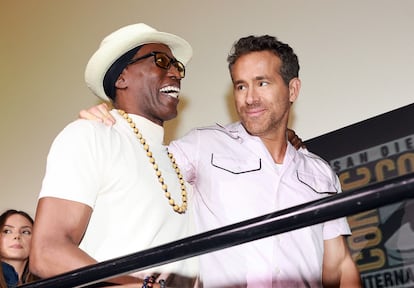Wesley Snipes: From disgraced action hero to breaking Guinness World Records
The actor’s cameo in ‘Deadpool and Wolverine’ as the vampire hunter Blade is causing a media stir, nearly three decades after the same role gained him a reputation as being a difficult person to work with

Just days before the release of Deadpool & Wolverine — the 34th film in the hugely profitable Marvel Cinematic Universe starring Ryan Reynolds and Hugh Jackman— the franchise decided to go all out and introduce the actors with cameo appearances in the movie at the San Diego Comic-Con. Popular faces such as Jennifer Garner, Chris Evans and Channing Tatum appeared on stage, but the big surprise was Wesley Snipes, who has reprised his role as Blade, the vampire hunter who made him a world star in 1998.
There were more than a few reasons to be surprised by the appearance of the 61-year-old actor. Firstly, Marvel had already confirmed that a new Blade film will be released in 2025, but that the lead role would be played by Oscar winner Mahershala Ali. Secondly, after filming the third movie in the famous trilogy — Blade: Trinity — Snipes was seen as being a difficult person, a reputation that does not fit with the image of the Marvel superhero franchise. And, thirdly, the actor — who rose to fame in action films in the 1990s — spent time behind bars after being convicted of several tax crimes, and since his release, has hardly starred in any movies or TV shows, let alone major productions.
“I did not think it was possible,” the actor admitted in an interview with Entertainment Weekly, in reference to his latest cameo. “I didn’t think we would be able to pull it off. I didn’t think that Marvel was into it, Disney was into it — also because they had Mahershala cast for the next upcoming version of it. I thought it didn’t make sense to me, but [when] you get a call from Ryan Reynolds out of the blue after 20 years, you go, ‘Okay, I got to take this call. Let’s see what this is about,’” he continued. “He told me the idea... They said ‘yes’ and ‘it’s a go.’ ‘If you’re in, we’re in.’ Here we are.”
Snipes’ cameo as Blade has earned him two Guinness World Records: the “longest career as a live-action Marvel character” — 25 years and 340 days have passed between his first appearance as the half-vampire to his cameo in Deadpool & Wolverine — and the longest gap between character appearances in Marvel films. But despite the applause and public excitement, it is still unclear whether Snipes will mount a comeback in light of Hollywood’s new sensitivity.

There was a time when Wesley Snipes had what it took to become one of the biggest stars in Hollywood. He proved his skills as an action hero in films such as Passenger 57 (1992) and Demolition Man (1993). He tried his hand at comedy in films such as White People Can’t Jump (1992) and To Wong Foo, Thanks for Everything! Julie Newmar (1995). And he worked with some most important names in the industry, such as Spike Lee, to make it known that he was a serious actor who couldn’t by typecast. But it was Blade that made Snipes a household name. The 1998 movie — the first of the trilogy — springboarded the actor to global fame.
But the tide turned against Snipes after the release of Blade: Trinity, the third film in the saga. Years later, veteran actor and comedian Patton Oswalt, a co-star in the film, said that the production was a disaster from start to finish, and complained that Snipes was impossible to work with: “Wesley [Snipes] was just fucking crazy in a hilarious way. He wouldn’t come out of his trailer, and he would smoke weed all day,” he said in 2012. “I remember one day on the set — they let everyone pick their own clothes — there was one Black actor who was also kind of a club kid. And he wore this shirt with the word ‘Garbage’ on it in big stylish letters. It was his shirt. And Wesley came down to the set [...] and goes, ‘There’s only one other Black guy in the movie, and you make him wear a shirt that says Garbage? You racist motherfucker!’”
Oswalt also shared other stories that did not help Snipes’ reputation: he said Snipes only appeared to film close-ups, leaving everything else to his stunt double, that he insisted everyone call him Blade on set, and that he had tried to “strangle” the film’s screenwriter and director, David Goyer, after an argument. After that, according to Oswalt, Snipes only communicated with the director through post-its, which he signed “From Blade.”
Goyer never confirmed those rumors, but he didn’t deny them either: “Let’s just say I have tremendous respect for Wesley as an actor. He used to be a friend. We’re not friends anymore. I am friends with Patton and I worked with Patton since so … I don’t think anyone involved in that film had a good experience on that film, certainly I didn’t. I don’t think anybody involved with that film is happy with the results. It was a very tortured production,” he told The Hollywood Reporter.
Snipes has a different account of what happened. The actor denied many of the accusations and, in a 2020 interview with The Guardian, argued that these attacks had racist overtones that the media of 2004 overlooked.
“Let me tell you one thing. If I had tried to strangle David Goyer, you probably wouldn’t be talking to me now. A Black guy with muscles strangling the director of a movie is going to jail, I guarantee you,” Snipes told The Guardian. “This is part of the challenges that we as African Americans face here in America — these microaggressions. The presumption that one white guy can make a statement and that statement stands as true! Why would people believe his version is true? Because they are predisposed to believing the Black guy is always the problem.” The actor said this treatment was unfair: “And all it takes is one person, Mr. Oswalt, who I really don’t know. I can barely remember him on the set, but it’s fascinating that his statement alone was enough to make people go: ‘Yeah, you know Snipes has got a problem.’”

However, the final nail in Snipes career would come in 2008, when he was sentenced to 36 months in prison for failing to file taxes between 1999 and 2004, when he was earning around $37 million a year. Snipes served a two-and-a-half-year sentence in a federal prison in Pennsylvania, and was released in 2013.
“I came out a clearer person,” the actor said in 2020. “Clearer on my values, clearer on my purpose, clearer about my relationship with my ancestors and the great god and the great goddess above, and clearer on what I was going to do once I had my freedom back.”
He took an important lesson from his time in prison: “The biggest thing I got from it was learning the value of time and how we often squander it ... I understand that very clearly now, having been away from my family and loved ones two and a half years.”
When he left prison, several friends reached out to him. Sylvester Stallone, who had previously offered him a role in the first film of The Expendables, invited him to take part in The Expendables 3 (2014), in which Snipes starred alongside Arnold Schwarzenegger, Mel Gibson, Bruce Willis and Jason Statham.
A year later, Spike Lee offered the actor a small role in the film Chi-Raq. Actor Eddie Murphy also gave him a role in the 2021 sequel Coming 2 America. But the actor has struggled to find his way back into the spotlight. Maybe the Marvel cameo will help...
Sign up for our weekly newsletter to get more English-language news coverage from EL PAÍS USA Edition
Tu suscripción se está usando en otro dispositivo
¿Quieres añadir otro usuario a tu suscripción?
Si continúas leyendo en este dispositivo, no se podrá leer en el otro.
FlechaTu suscripción se está usando en otro dispositivo y solo puedes acceder a EL PAÍS desde un dispositivo a la vez.
Si quieres compartir tu cuenta, cambia tu suscripción a la modalidad Premium, así podrás añadir otro usuario. Cada uno accederá con su propia cuenta de email, lo que os permitirá personalizar vuestra experiencia en EL PAÍS.
¿Tienes una suscripción de empresa? Accede aquí para contratar más cuentas.
En el caso de no saber quién está usando tu cuenta, te recomendamos cambiar tu contraseña aquí.
Si decides continuar compartiendo tu cuenta, este mensaje se mostrará en tu dispositivo y en el de la otra persona que está usando tu cuenta de forma indefinida, afectando a tu experiencia de lectura. Puedes consultar aquí los términos y condiciones de la suscripción digital.
More information
Archived In
Últimas noticias
Most viewed
- Sinaloa Cartel war is taking its toll on Los Chapitos
- Oona Chaplin: ‘I told James Cameron that I was living in a treehouse and starting a permaculture project with a friend’
- Reinhard Genzel, Nobel laureate in physics: ‘One-minute videos will never give you the truth’
- Why the price of coffee has skyrocketed: from Brazilian plantations to specialty coffee houses
- Silver prices are going crazy: This is what’s fueling the rally











































